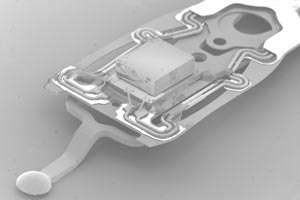Electro-thermal actuator and lever system keeps hard drive recording heads on track

As the density of data stored on a hard drive gets close to multiple terabytes per square centimeter, the precision of the internal components is becoming increasingly significant. A*STAR researchers have designed a system that achieves a new milestone in micro-positioning, and it could become the next industry standard.
Like a 21st century update of the gramophone record, hard disk drives consist of thin magnetic platters with data bits arranged on concentric tracks. The data bits are read and written by a magnetic recording head that floats a few nanometers above the platter surface at the end of a 'slider' arm, while the platter spins at high speed beneath it.
But unlike an old record, a modern disk drive contains up to a million tracks per inch and track widths as narrow as 25 nanometers. And that density is increasing every year. This means future disk drives will require extraordinarily precise head positioning and responsiveness to meet performance expectations.
"The actuator mechanism will need to be able to position the recording head with a precision of just one or two nanometers," explains Jiaping Yang from the A*STAR Data Storage Institute. "The actuator schemes commonly used today can offer a fast response, but will have difficulty achieving the positioning accuracy needed for future high-density drives."
Yang and his colleagues from A*STAR and Nanyang Technological University in Singapore have been investigating the possibility of using an electrically activated thermal expansion element to control the position of the recording head at the end of the slider. The latter provides the larger-scale movement needed to navigate across multiple tracks.
Their electro-thermal element is called a thermal unimorph and it consists of a comb-like set of silicon teeth interlaced with polymer expanders. Yang says: "Silicon has high thermal conductivity but small thermal expansion, while the polymer expander has a large thermal expansion coefficient, but low thermal conductivity. When we resistively heat the element by applying electricity to the silicon, the polymer expands, causing the silicon comb to bend."
Although the thermal unimorph can be controlled with nanometer precision, its range of motion was previously too limited to be of practical use. Yang and his team overcame this limitation by adding a rotary lever action that magnified the stroke length by six times.
"We are now exploring possible approaches to improve actuation speed performance, such as designing a more efficient heat path, investigating new thermally active materials, and further miniaturization of the actuator footprint," says Yang.
More information: Gih Keong Lau et al. An electro-thermally activated rotary micro-positioner for slider-level dual-stage positioning in hard disk drives, Journal of Micromechanics and Microengineering (2016). DOI: 10.1088/0960-1317/26/3/035016
Journal information: Journal of Micromechanics and Microengineering




















